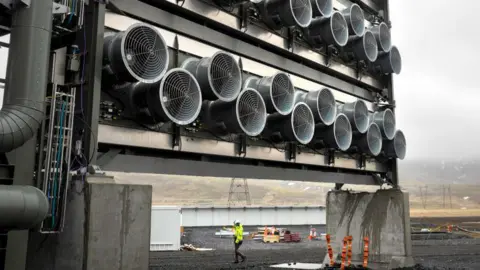 Getty Images
Getty ImagesIt could be a scene from science fiction. Towering above the dark, mossy lava fields are stacks of rumbling machines the size of shipping containers, domes and zig-zagging silver pipes.
Located 30 km (19 miles) southwest of Iceland’s capital Reykjavik, this is the world’s largest direct aerial capture (DAC) facility.
Called Mammoth, it was developed by Swiss firm Climeworks.
It has been operating for two months, absorbing global-warming carbon dioxide (CO2) from the air, then storing it deep underground, where it turns to stone.
Twelve collector containers are now installed, but in the coming months 72 of them will surround the large processing hall.
“This will enable us to capture 36,000 tonnes of CO2 every year,” Climeworks chief commercial officer Douglas Chan tells the BBC.
The idea is to cancel the emissions that have already been released into the atmosphere.
Each collector unit has a dozen powerful fans that, every 40 seconds, can suck in enough air to fill an Olympic swimming pool.
“The technology relies on taking in lots and lots of air, slowing it down so the filter can catch it, and then blowing the air out the bottom,” says Mr Chan.
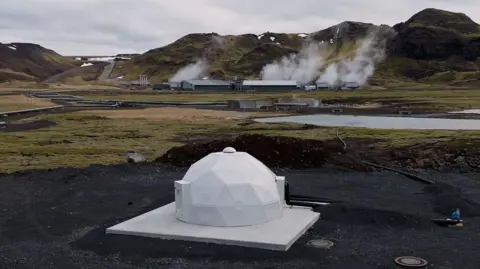
CO2 makes up only a small fraction of the atmosphere (0.04%), so capturing it requires a lot of electricity.
For Mammoth, the electricity comes from a neighboring geothermal power plant, so when operating, the power plant is emission-free.
Once filled, the collection chambers are flushed with hot steam, which is fed into the processing hall.
Inside the hall, Mr. Chan points out two large cylinders overhead, which together hold a single ton of CO2.
That captured CO2 is then mixed with fresh water in an adjacent tower.
“It’s almost like a shower,” explains Dr Martin Voigt, of the Icelandic firm Carbfix, which has developed a process to turn CO2 into stone.
“From the top, water flows down. CO2 is coming up and we are releasing CO2.”
Hidden inside two white, igloo-like domes nearby are injection wells, where CO2-laden water is pumped more than 700 meters underground.
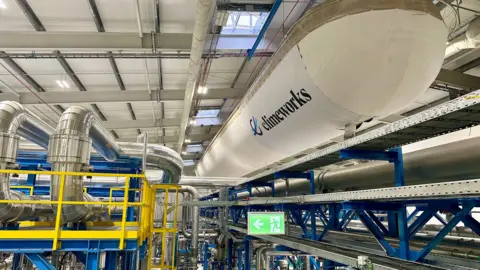
“This is fresh basalt here,” says Dr Voight, showing me a piece of black rock taken from a recent volcanic eruption and riddled with small holes. “You can see there’s a lot of porosity.”
Iceland has an abundance of volcanic basalt, and this rock acts as a storage reservoir. When carbon meets other elements found in basalt, a reaction begins and it solidifies, sealing it as carbonate minerals.
“You can see here that many of these pores are now filled with white flecks,” says Dr Voight, handling a sample of drilled rock.
“Some of these are carbonate minerals. They contain mineralized CO2.”
The process is fast, Dr Voight enthuses. “We’re not talking about millions of years.”
“About 95% of the CO2 was mineralized within two years in the pilot project. This is incredibly fast. At least in geological terms.”
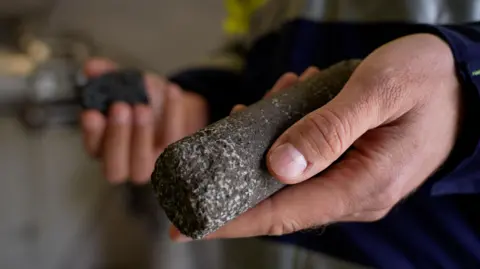
Capable of removing 36,000 tonnes of CO2 per year, an amount similar to taking 8,000 petrol cars off the road, Mammoth is almost 10 times larger than Climeworks’ first commercial plant called Orca.
It costs Climeworks almost $1,000 (£774) to capture and store a tonne of CO2. To make money, it sells carbon offsets to customers.
“Mammoth has already sold close to a third of its life capacity,” says Mr Chan, who believes technological improvements and growth will lower future costs.
“By the end of the decade, we want to have a capture cost between $300 and $400.”
Among its clients are Microsoft, H&M, JP Morgan Chase, Shopify and Lego; as well as over 20,000 individuals who subscribe to the Climeworks website.
“We’re following the science,” Microsoft’s senior director of energy and decarbonisation, Brian Marrs, previously told the BBC.
“Carbon removal has to be part of the equation. You can’t reduce emissions that are already in the atmosphere, you have to remove them.”
Mammoth will eventually be dwarfed by the US-based Cypress Project, which opens in 2026, and which Climeworks hopes will remove up to one million tonnes of CO2 a year, using new technology it claims will be cheaper and more energy efficient.
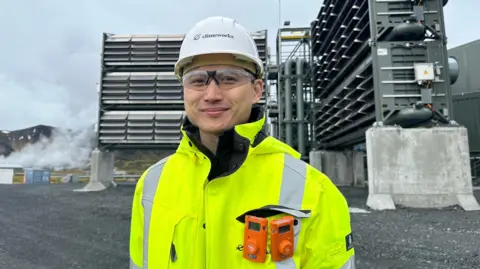
DAC technology, however, is not without critics who feel it is overkill, citing high costs, high power consumption, and limited scalability.
These critics would argue that capturing CO2 where it is emitted would be much more efficient.
“It’s much easier to remove carbon dioxide directly from smokestacks,” says Dr Edvard Júlíus Sólnes, a professor at the University of Iceland and former Icelandic environment minister.
Despite repeated calls to curb emissions, a record amount of planet-warming CO2 was emitted last year.
The UN’s Intergovernmental Panel on Climate Change has warned that emissions must be cut urgently, but this will still not be enough to prevent harmful global warming.
Many climate scientists agree that carbon removal will also be necessary, but that also divides opinion. Numerous methods have emerged and some caution against relying on so-called technical fixes, which may discourage polluters from changing their ways.
Currently, no carbon removal is taking place anywhere near the scale that would be necessary.
“We release about 40 billion tons of carbon dioxide into the atmosphere every year, so this [DAC] it will not affect the big problem,” says Dr Sólnes.
“We must give up fossil fuels and find other sources of energy,” he asserts. “But I think we should use all methods to fight this problem.”
More DAC projects are underway. According to the International Energy Agency, 27 plants are in operation worldwide, but only four of them capture more than 1,000 tons of CO2 per year.
Plans for another 130 facilities are also on the table, and about $3.5 billion has also been earmarked by the US government to launch three large-scale centers that aim to eventually remove one megaton of CO2, per year.
However, Doug Chan is convinced that DAC can help fight global warming. “I really believe that direct air capture and other engineered solutions will get us where we need to be to help fight climate change.”
